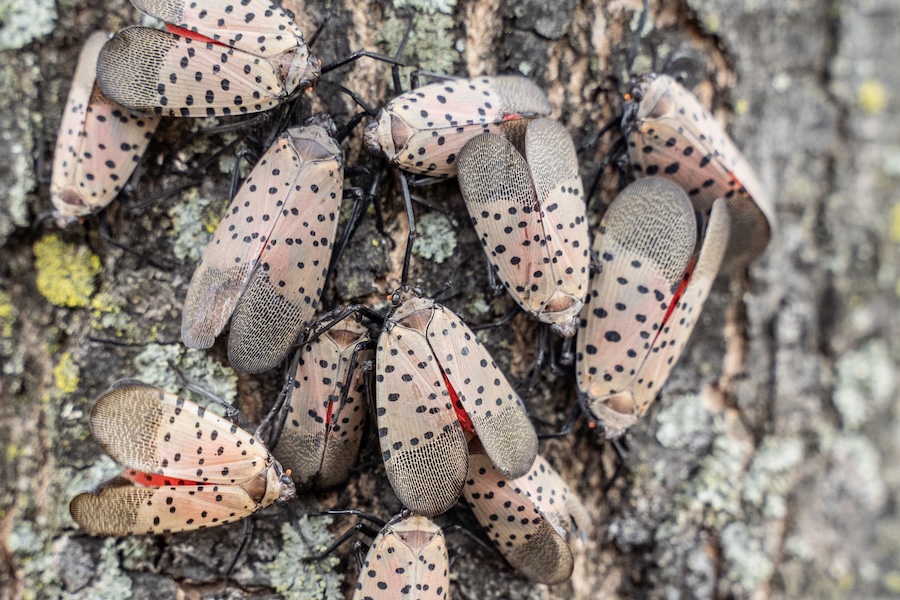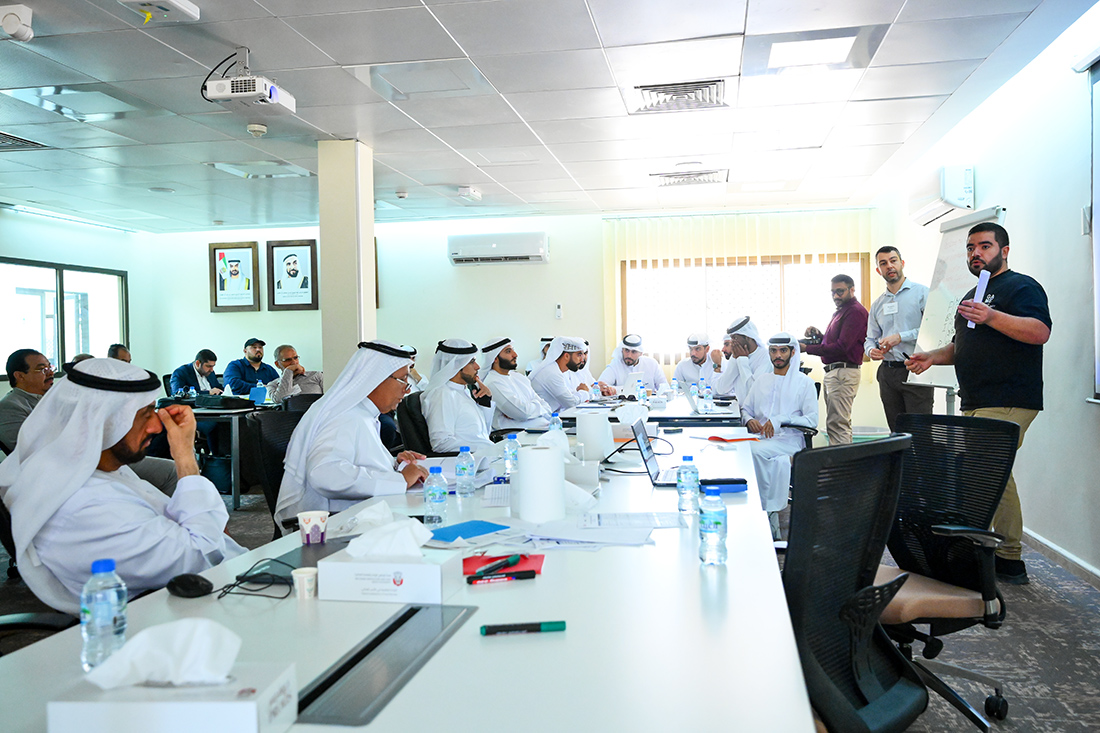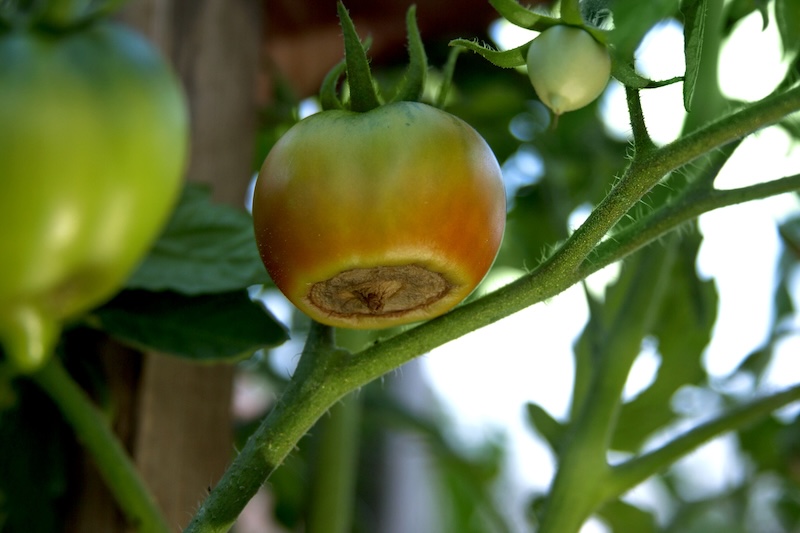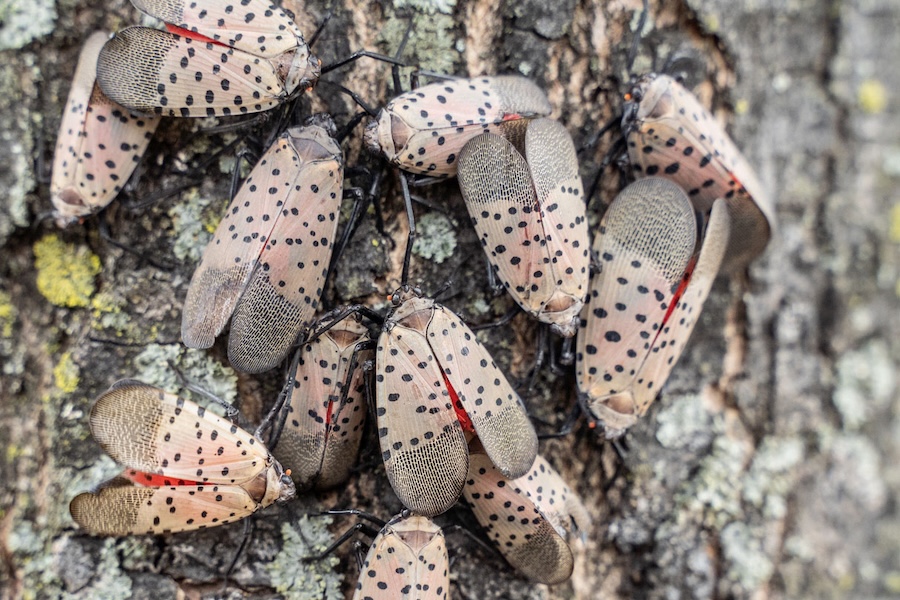
Despite its striking appearance, with bold orange wings and eye-catching patterns, the spotted lanternfly (Lycorma delicatula) is far from the welcome guest it may seem. This invasive insect has made its way to Georgia, posing a significant economic threat to agriculture and threatening residential landscapes with tree damage.
Native to several Asian countries, this planthopper was first detected in the United States in 2014 in Pennsylvania, likely arriving via imported goods. Since its arrival, spotted lanternfly (SLF) has spread to 15 states in the Eastern U.S., now including Georgia. While they do not bite or sting humans or animals, University of Georgia experts stress that early detection, prevention strategies and timely interventions are crucial to minimizing the spread and impact of this pest on a variety of plants, including grapevines, fruit trees and hardwoods.
Elizabeth McCarty, a forest health outreach specialist with UGA Cooperative Extension and associate professor at the Warnell School of Forestry and Natural Resources, emphasized that landscape professionals and the general public are vital to early detection efforts. SLF was first reported and confirmed in Fulton County, Georgia, in November by a crew member of a landscaping company.
Distribution patterns
“It appeared exactly where I would have expected it — more of an urban area where there’s more commerce and human activity,” McCarty said.
Although SLF have wings, they primarily walk or jump short distances, McCarty explained. “The primary means of their spread is not a gradual movement from one county to the next. They are primarily getting moved around on plant products, firewood, transportation vehicles and nursery goods that carry their egg masses, which highlights the importance of vigilant monitoring.”
Females lay egg masses on a variety of surfaces, including tree bark, vehicles and outdoor furniture, making it easy for humans to inadvertently transport them to new areas.
Compounding the issue, tree of heaven (Ailanthus altissima) — an invasive plant and the SLF’s preferred host — is widely distributed across the U.S., including Georgia, and thrives along roadsides, creating ideal conditions for SLF population establishment and dispersal.
Observations over time will be crucial for understanding how SLF behaves in Georgia. UGA Extension entomologists Will Hudson and Shimat Joseph, faculty with the Department of Entomology in the College of Agricultural and Environmental Sciences (CAES), explained that the pest’s ability to thrive in southern Georgia might be limited by the scarcity of tree of heaven, a plant essential for its reproduction. However, they noted that wild muscadine grapes, abundant in non-managed areas across the state, could serve as an alternative host. They emphasized the importance of monitoring SLF distribution to assess its potential statewide impact.
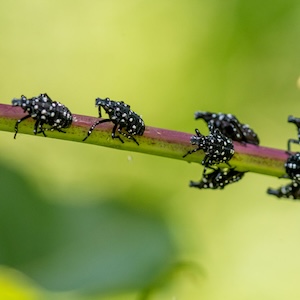
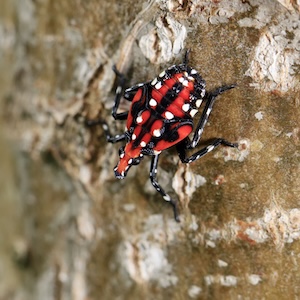
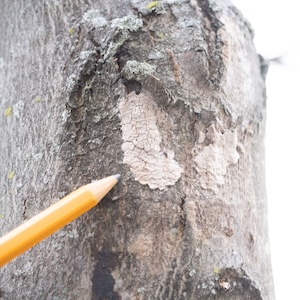
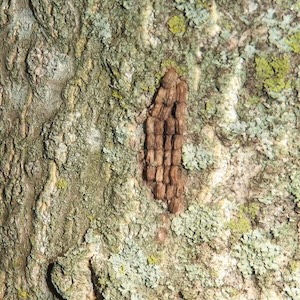
Identifying and reporting spotted lanternfly
Proper identification is crucial for effective management. Recently laid egg masses appear whiteish but turn to a muddy grayish appearance as they age, making it challenging to immediately recognize. Egg masses are often laid on flat surfaces like trailers, shipping crates, RVs and vehicles, making them easily transportable across state lines.
McCarty explained that young nymphs emerge in spring, starting as black with white spots before developing red patches as they mature. Adults, which appear in summer, are 1 inch long and a half-inch wide with their wings closed. The front wings are generally grayish-brown with black spots, and the back wings have brown, red and light-colored patches.
“This life-cycle timing is based on areas further north of us, where SLF have already been established,” said McCarty, “so we’ll have to see if and how life cycle development differs over time with our warmer temperatures further south.”
If you suspect you have SLF present at any of the described life stages, McCarty encourages residents to follow these critical steps:
- Take a clear picture.
- Kill live SLF or scrape off egg masses.
- Report your sighting online through the Georgia Invasive Species Task Force website.
Reports are reviewed by a network of experts who verify submissions and follow up with next steps for management. “Reports like these are reviewed quickly, and public participation allows us to target management efforts effectively,” McCarty said.
Rebekah Wallace, program coordinator at the UGA Center for Invasive Species and Ecosystem Health, oversees data coordination for the EDDMapS database. This free mobile and web app draws from state, local and private data to track invasive species throughout the U.S.
Public engagement in the response process is extremely important, Wallace said, explaining that reports submitted through tools like the app or online from Georgia Invasives are forwarded to the appropriate expert within a network of verified specialists. Each report is reviewed and, based on the threat posed by the reported species, specialists will respond with appropriate follow-up information upon confirmation of SLF.
Managing the impact
While SLF does not generally kill established woody perennials, they have been linked to the death of young vines and saplings, and the pest is of particular risk to newly established plantings, explained Sarah Lowder, UGA Extension viticulturist and assistant professor in the CAES Department of Horticulture.
“Even when it doesn’t kill the established vines or other fruit crops, there are significant associated losses in yield and quality of grapes and other affected crops,” Lowder said.
Additionally, the insects’ sap-feeding behavior weakens host plants, leaving them vulnerable to other stressors. The pest’s sticky excrement, called honeydew, promotes sooty mold growth and attracts other nuisance insects like ants and wasps.
McCarty acknowledged that while researchers are studying management strategies used in Northeastern states, pesticide recommendations for Georgia are being considered. “Over time, we’ll have more common insecticide practices, but right now, the first step is to understand how widely SLF is distributed in Georgia,” she said.
In the meantime, experts encourage practices such as sourcing local firewood to prevent unintentional transport of egg masses and inspecting shipments of nursery plants and other goods for signs of infestation.
Wallace advises doing routine checks of vehicles and equipment if traveling from known SLF-infested or quarantine areas to minimize the chance of inadvertently carrying the pest into new areas.
McCarty and her team have also created peer-reviewed educational materials, including coloring sheets and identification guides, to help raise awareness.
Why reporting matters
Public participation is key to mitigating the spread and impact of SLF in Georgia. “If we know where they are, we can better manage them to reduce the negative effects on people’s livelihoods, finances and landscapes,” McCarty said.
Public reporting allows experts to monitor the pest’s distribution. “It’s not just that the insect isn’t present in certain places – it could be that people aren’t reporting it. Public vigilance helps us know where they exist and how to respond,” Wallace added.
For additional resources and updates, visit the Georgia Invasives website.
